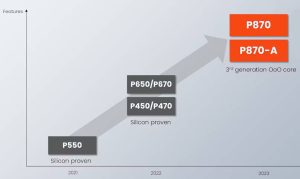
“Performance P870 and Intelligence X390 offer a new level of low power compute density and vector compute capability, and when combined provide performance for data intensive compute,” according to the company, which is advocating combining the general-purpose scalar P870 with an NPU cluster consisting of the vector X390 and customer AI hardware intellectual property.
Performance P870
For consumer applications or, with a vector processor, datacentres, P870 has 50% more peak single thread performance (specINT2k6) that its previous Performance branded processors.
It is a six-wide out-of-order core, that meets RVA 23 and offers a shared cluster cache up to 32 cores.
“High execution throughput comes with more instruction sets per cycle, more ALU, and more branch units,” said SiFive.
The core is compatible with Google Android-on-RISC-V requirements, and has x128b VLEN RVV, vector crypto and hypervisor extensions, IOMMU and AIA, non-inclusive L3 cache and WorldGuard security.
P870-A has added features for automotive use.
Intelligence X390
Compared with its X280 forebear, X390 has a 4x improvement to vector computation in single core configuration, doubled vector length and dual vector ALUs.
“This allows quadruple the amount of sustained data bandwidth,” said SiFive. “With VCIX [vector coprocessor interface extension] companies can add their own vector instructions and acceleration hardware.”
VCIX is 2,048bit out, 1,024bit in, and other features include: 1,024bit VLEN, 512bit DLEN and single-dual vector ALU.
 Electronics Weekly Electronics Design & Components Tech News
Electronics Weekly Electronics Design & Components Tech News




They do not compare performance with ARM or x86 probably because it is inferior. The progress bodes well for RiskV.
Morning Fast Eddie
Personally, I would rather they compare performance with their own processors, as it is easier to trust this sort of comparison.
Once the RISC-V ecosystem improves – and that Rise Project (RISC-V Software Ecosystem Project) has some big backers – I suspect RISC-V instruction set cores will become another good option for all sorts of products.